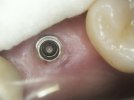lcmlabforum
Well-Known Member
Full Member
- Messages
- 1,476
- Reaction score
- 160
Interesting case thought I best share . . .
This was pt from last week, glad took a good look and noticed after second look/cleaning debris below - pt had new screw placed just Jan 2022

Fortunately, I took pictures in Jan 2022 also . . . and pt not upset once he saw this because he also knows I insist on ordering original implant manufacturer parts.


Maybe Darwin or some others working with manufacturers can chime in - Quality control issue or design flaw?
LCM
This was pt from last week, glad took a good look and noticed after second look/cleaning debris below - pt had new screw placed just Jan 2022

Fortunately, I took pictures in Jan 2022 also . . . and pt not upset once he saw this because he also knows I insist on ordering original implant manufacturer parts.


Maybe Darwin or some others working with manufacturers can chime in - Quality control issue or design flaw?
LCM


 !
!